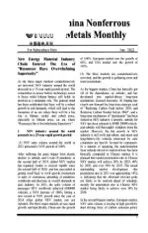Pingguo County in Baise,Guangxi has Finalized Aluminum Industry Development Plan for the Next Five Years
2011-08-15
According to news published on March 22nd,recently the County CPC Committee and County Government of Pingguo County, Baise City, Guangxi Zhuang Autonomous Region,has reviewed and approved “Pingguo County Aluminum Industry Development Plan”, which decided to regard aluminum industry as its development direction in the next five years.
In the next five years, this county will further implement the strategy of “Rejuvenating Pingguo County through aluminum, and privateowned economy”, adhere to the practice of us-ing resource to develop industry, and using reserve to achieve increase, by focusing on extending aluminum industrial chain and building up aluminum industry cluster, deepen reform and technological innovation, prioritize the development of aluminum oxide and aluminum,vigorously develop aluminum processing, promote clean production, develop circular economy, promote the aluminum industry to develop in a fast and healthy way, in order to build Pingguo county into an important aluminum industry base in the whole region and even in the whole nation. The Plan proposed that by 2015 it will achieve deep extension of aluminum industrial chain, complete industrial supporting facilities, well-developed industrial service system, strong industry competitiveness,formation of industrial cluster, and basically develop a modern aluminum industry development system combining R&D, processing, inspection, market transaction, and integrated supporting services; fulfill annual output of 2,200,000 tonnes of aluminum oxide, 800,000 tonnes of aluminum, 1,000,000 tonnes of aluminum processing, 1,000,000 tonnes of Corundum, 600,000 tonnes of pre-baked anode fluoride salt; its investment in aluminum industry will reach 13.9 billion yuan, output value of aluminum industry can reach 40 billion yuan,profit tax of the aluminum industry can reach 6 billion, and offer new jobs to 23,000 persons.
杂志排行
China Nonferrous Metals Monthly的其它文章
- Nonferrous Industry’s Twelfth Five Year Plan Has Taken Shape, The Industry Will Develop 10 10,000,000 yuan Groups
- Ministries and cCommissions Including the National Development and Reform Commission Plan to Stop 70 Billion Worth of Aluminum Projects
- Jiaozuo City Signed Strategic Cooperation Agreement for 300,000 t/a Aluminum Profile with Guangdong Fenglu Aluminum
- Four Key Points for Observation in the Accelerated Growth of Lead Acid Battery Industry
- Jiangxi Tungsten Industry Group Co., Ltd Plans to Fulfill Operating Income 12 billion in 2011
- Export Rebate Rate of Nonferrous Products will be Lowered,Intending to Promote Integration of the Nonferrous Industry
